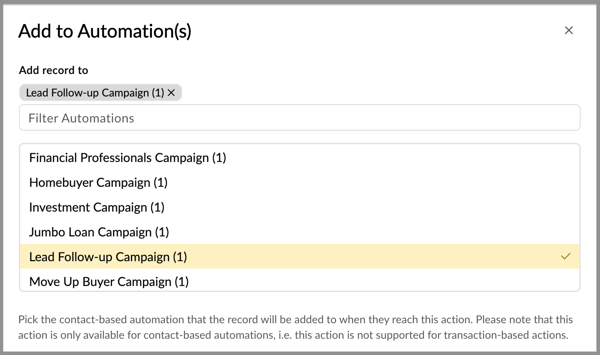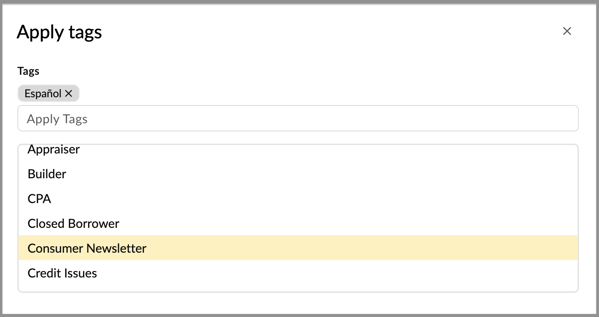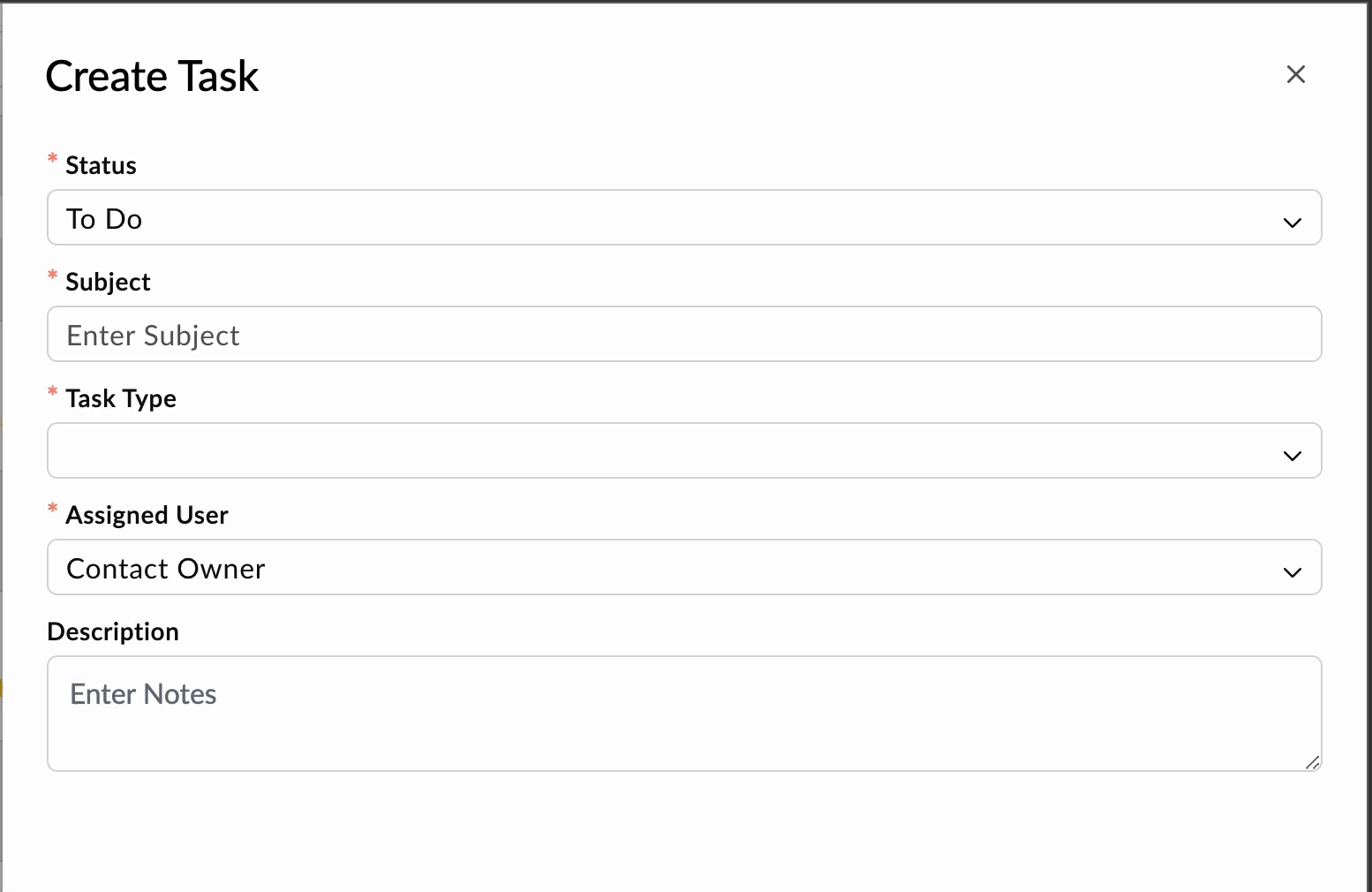Contact-Based Automations
Contact-based automations are designed to support your lead management, contact engagement, education, reminders, and more. These automations help you act on your best intentions without manual follow-up.
- What is a contact based automation
- Create new automation
- Set automation for manual assignment
- Set automation for automatic assignment
- Build the 'actions' in an automation
- Publish/activate an automation
What is a Contact Based Automations
A contact based automation affects only contacts, not transactions. You will have two types of these automations, automatically assigned and manually assigned.
An automatically assigned automation are for things you want to happen based on Contact Status, details, lead source and many others. Additionally, these will be used for date based events, like birthday greeting and loan anniversary check-ins. An automatic assignment is managed by 'Entrance Conditions'. These are contact based filters that will use the details from the contact record to add the automation.
A manually assigned automation are for situational events or when a user is to decide the next best course of action. These are commonly used for drip (nurture) campaigns, lead nurture and your teams custom lead management and follow-up procedures.
Either of these types can include the following 'Actions':
- Delays – Add a pause in the workflow by a specific amount of time, day of the week, or date.
- Email – Send a templated email using merge fields to inform, educate, or follow up with your contact.
- SMS (Text Message) – Send a short-form update or notification from your team’s CRM number.
- Webhook – Connecting with External Systems
- Lendware Agents – Intelligent Suggestions That Put You in Control
- Assign to Automation – When relevant, assign the contact to another contact-based automation to keep workflows connected.
- Task – Create a task assigned to a specific user or user type, to be completed after a set delay.
- Tags – Apply one or more tags to help organize and segment your contacts for better tracking.
- Update Status – Change the status of the current entity (like a transaction) or any related contact (borrower/co-borrower, for example).
⚠️ Automations run once per contact. For testing, create new test contacts to ensure proper assignment.
⚠️ SMS actions will pause if sent after 9 PM in your team’s time zone and resume at 9 AM.
👍 This concludes what is a contact based automation
Create New Automation
- To create a new automation, choose 'Automations' in the menu group on the left side.
- Click the '+ Create Automation' button in the upper-right corner.
- At this point, the automation builder will load on the screen. The next step is to name your automation. It's incredibly important that you have a consistent, logical and recognizable naming convention. This is especially important when creating a Manually added automation, however, it is also important for automatically assigned automations when viewing what automations are currently assigned to a contact, as well as, viewing completed automations.
Initially, it will say, 'Untitled Automation' - click in that text box to edit.
Edit the text to name your new automation - You can change the name later, at any time, without affecting the automation or it's assignments. - The last step to create the automation, before customizing, you will chose the 'Automation Purpose'. In this case, we will choose, "Contact-based automation", then decide whether you want a campaign or a workflow. Once selected, click the yellow Save button.

👍 This concludes creating a new automation - now it's time to set the 'Entry Conditions'
Set automation for manual assignment
Setting an automation for manual assignment/add only, simply leave the 'Entry Conditions' empty. There is nothing to do in this section.
👍 This concludes setting an automation for manual assignment
Set automation for automatic assignment
When you want an automation to assign to a contact automatically based on the source, contact details or tags contained within the contact record, you can use 'Entrance Conditions'. You can add a single condition or multiple conditions to determine when and how an automation is assigned automatically.
For example, a birthday greeting can use the following entry conditions:
- Contact status equals New Lead
- Contact Mailing State equals NY
The completed entrance conditions will look like this:
You can also add Condition Groups to expand the reach of your entrance conditions while also narrowing them down. By adding a condition group, you can provide more than one way for a contact to enter an automation. For example, we want to trigger based on a contact that is in more states like KY and have a tag, "Poor Credit". To do so, we will want the following condition groups.
- Mailing State = NY and Tag = "Poor Credit"
- Mailing State = KY and Tag = "Poor Credit"
The completed entrance conditions will look like this:
⚙️ To learn how repeat on anniversary automations work and how to setup their entry conditions, click here
👍 This concludes setting an automation for automatic assignment
Build the 'actions' in an automation
Actions are added one at a time and you can choose to whom outbound actions are sent, emails and SMS. You can also assign tasks to specific users with delayed due dates. Tags can be added to the assigned contact to assist with keeping your contacts organized and potentially triggering future automations. Finally, you can also assign existing automations to continue follow-up or nurturing.
Adding Actions is effectively the same no matter the Entrance Conditions added to your automation. After you do or do not setup your entrance conditions, you will look for the following in the automation builder.
After clicking the '+ Add Action' button, a slide-out will appear on the right. From there we will choose the action we want to add. To begin, it's best to add a 'Delay' action. Even if the delay is just a few seconds, by adding a delay first, it will always be available provide flexibility for future automation edits. Next we will set the delay to 10 minutes and click, 'Apply' at the bottom-right.
Now, we have our first action complete and it will look like this:
🎉 In many systems, delays are built directly into each action. Lendware believes you should be able to view every action, including delays, to allow for easy evaluation of a completed automation. Therefore, each delay is a separate step. Most likely, you will come to appreciate this methodology, especially when adding or updating existing automations.
Next, we will add a SMS (text message) action by clicking the '+' button, in yellow, below the previous action.
A SMS will always be from the Team CRM number and in this case we will make the To = Client (this contact). There are additional 'send to' options, including the following 'Linked' contacts: Spouse, Referred By and Business Partner. Also, when creating automation SMS' or emails, it is recommended to utilize merge fields to give the messages a very custom and familiar feel.
Now that we are happy with our SMS message, we click, 'Apply' at the bottom-right. This is now what our automation actions look - Noting that it will display the action type (SMS), to whom the SMS will be delivered, as well as a truncated version of the message itself.
Emails are built in a similar way to a SMS action. Simply choose Email when adding a new action. For more information on how to create emails, see this article.
In addition to a delay action, SMS action and Email action. You will see 5 action options more, Webhook, User Input Notification, Add to Automation(s), Apply Tags and Create Task. Next, we will choose, Add to Automation(s).
Compliance Note: The TCPA prohibits sending text messages before 9:00 AM or after 9:00 PM.
-
Emails will still send outside these hours.
-
Text messages scheduled outside these hours will be queued and delivered at the next available compliant time.
After we chose, 'Add to Automation(s)', the slide-out will allow us to choose 1 or more Contact based automations. It's important to be very careful which and how many automations you use this method to assign. The following image will show how easy it is to add an existing automation. It may be helpful to find the automation we're looking for by typing out the automation name in the 'Filter Automations' box. Once we choose the automation to add, we will click the 'Apply' button on the lower-right.
Next, we will choose 'Apply Tags' action to add one or more tags to the contact. Just like the Add to Automation(s) action we just added, the Apply Tags action will allow you to add one or more tags to this contact.
Create Task For this, we will assign a follow-up task to a member of our team. We will be provided with the following options to edit: Status, Subject, Task Type, Assigned User and Description. To learn more about tasks, see this video walk-through.
To demonstrate adding a task action, see the animated GIF below.
Update Status - Changing or updating the Client and Co-borrower contacts is a must to keep our contacts well organized. Be sure to update the status at the truly important milestones. Like, Sent to Processing, Pre-approved and Loan Closed.

Webhook – Connecting with External Systems
Using a webhook action allows you to extend the power of your automation beyond Lendware. A webhook can send data to another application whenever your automation is triggered, creating seamless integrations with third-party systems. Simply configure the endpoint URL, define the data you’d like to pass along, and Lendware will handle the rest automatically. This is especially useful for updating CRMs, triggering notifications in external apps, or syncing records across platforms.
Learn more about using webhooks in automations →
Lendware Agents – Intelligent Suggestions That Put You in Control
Lendware Agents are designed to provide smart, contextual suggestions as you build your automations. They help ensure that your workflows are not only functional but also optimized for efficiency and clarity. Agents may recommend actions, highlight potential improvements, or flag settings you might have overlooked. While the final decision always stays with you, Lendware Agents make it easier to create well-structured, high-performing automations.

Learn more about Lendware Agents →
Behavior – Controlling How and When Messages Are Sent
Stop on Reply - When Stop on Reply is turned on, any reply from a contact will immediately suspend the remaining messages in the automation. This ensures that once a contact engages with you, no further automated actions are executed—helping keep communication natural and responsive.
Allowed Communication Times - You can control when contacts receive communications by setting specific days and times for delivery. This ensures your outreach is both effective and compliant.
Set Days
- Weekdays: Select Monday through Friday (or all at once).
- Weekends: Select Saturday and Sunday (or both together).
Set Time
Choose the window of time during which messages can be sent. The default is based on your team’s time zone (e.g., America/Denver), but this will vary depending on your team. You can update your team’s time zone in your Team Settings.

Exit Conditions
Choose Exit Conditions (Optional)
Set the exit conditions for this automation step. If the specified conditions are met, the transaction will automatically be removed from the automation process.
Just like with Entry Conditions, you can use “AND” or “OR” logic to combine multiple rules and fine-tune when a contact should exit the automation.

Now that we're happy with the automation, it's time to activate it. It's important that you click the 'Save Changes' button at the top-right before activating or 'turning-on' an automation.
👍 This concludes a walk-through of each available action type
Publish / Activate a Contact-Based Automation
Publishing a transaction-based automation in Lendware is simple and straightforward.
Once your automation is ready:
- Save your progress to ensure all changes are kept.
- Click Schedule.
Safety Feature:
After activation, the automation cannot be edited until you click the ‘Edit Automation’ button at the bottom. Once edits are made, always click Save to confirm changes.
Workflow Scheduling
You can choose when your automation will start:
Start Now - The automation will run immediately upon clicking Start Now.
-
Note: Cancelling will not be available once the automation begins.
Start Later - Select a specific date and time for the automation to begin.
-
The automation will automatically activate at the scheduled time.
Example:
-
Date:
09/25/2025 -
Time:
10:00 AM
This flexibility ensures your automations run at the perfect time for your team and contacts.
From this point forward, when any contact meets the entrance conditions you set for the automation, it will be automatically added/assigned to the contact.
👍 This concludes publishing an automation and additional options
Need more help? Check out: Campaigns vs Workflows